
SUMMARY OF CHALLENGES FACING THE SA POULTRY SECTOR
Author: lindy-dunigan | Published: 2025-05-24
Description: SUMMARY OF CHALLENGES FACING THE SA POULTRY SECTOR Presentation to the Portfolio Committee on Trade and Industry 23 March 2017 Overview Status of the domestic industry Why is there a crisis? Why it is important to support the industry and
Download Presentation
Download the PPT/PDF: Download
Transcript:
Loading transcript…